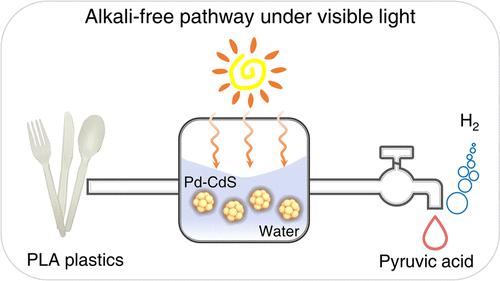当前位置:
X-MOL 学术
›
J. Am. Chem. Soc.
›
论文详情
Our official English website, www.x-mol.net, welcomes your
feedback! (Note: you will need to create a separate account there.)
Direct Photoreforming of Real-World Polylactic Acid Plastics into Highly Selective Value-Added Pyruvic Acid under Visible Light
Journal of the American Chemical Society ( IF 14.4 ) Pub Date : 2024-01-31 , DOI: 10.1021/jacs.3c13000
Yingxuan Miao 1, 2 , Yunxuan Zhao 1 , Junyu Gao 1, 2 , Jinhu Wang 1, 2 , Tierui Zhang 1, 2
Journal of the American Chemical Society ( IF 14.4 ) Pub Date : 2024-01-31 , DOI: 10.1021/jacs.3c13000
Yingxuan Miao 1, 2 , Yunxuan Zhao 1 , Junyu Gao 1, 2 , Jinhu Wang 1, 2 , Tierui Zhang 1, 2
Affiliation

|
Although polylactic acid (PLA) represents a pivotal biodegradable polymer, its biodegradability has inadvertently overshadowed the development of effective recycling techniques, leading to the potential wastage of carbon resources. The photoreforming–recycling approach for PLA exhibits significant potential in terms of concepts and methods. However, the reaction faces enormous challenges due to the limited selectivity of organic oxidation products as well as the increased costs and challenging separation of organic products associated with alkali-solution-assisted prehydrolysis. Herein, we report an alkali-free direct-photoreforming pathway for real-world PLA plastics utilizing the Pd-CdS photocatalyst under visible-light illumination, obviating the need for chemical pretreatment of PLA. The devised pathway successfully produces H2 at a rate of 49.8 μmol gcat.–1 h–1, sustained over 100 h, and exhibits remarkable selectivity toward pyruvic acid (95.9% in liquid products). Additionally, experimental findings elucidate that Pd sites not only function as a typical cocatalyst for enhancing the photocatalytic evolution of H2 but also suppress competitive side reactions (e.g., lactic acid coupling or decarboxylation), consequently augmenting the yield and selectivity of pyruvic acid and H2. This investigation provides a straightforward and sustainable direct-photoreforming route capable of simultaneously mitigating and repurposing plastic waste into valuable chemicals, thus offering a promising solution to the current environmental challenges.
中文翻译:

可见光下真实聚乳酸塑料直接光重整为高选择性增值丙酮酸
尽管聚乳酸(PLA)代表了一种关键的可生物降解聚合物,但其生物降解性无意中掩盖了有效回收技术的发展,导致碳资源的潜在浪费。 PLA 的光重整-回收方法在概念和方法方面表现出巨大的潜力。然而,由于有机氧化产物的选择性有限,以及碱溶液辅助预水解相关的成本增加和有机产物分离的挑战性,该反应面临着巨大的挑战。在此,我们报告了一种在可见光照射下利用 Pd-CdS 光催化剂对现实世界 PLA 塑料进行无碱直接光重整的途径,从而无需对 PLA 进行化学预处理。设计的途径成功地以 49.8 μmol g cat 的速率产生 H 2 。 –1 h –1 ,持续超过 100 小时,并对丙酮酸表现出显着的选择性(液体产品中为 95.9%)。此外,实验结果表明,Pd 位点不仅可以作为增强 H 2光催化演化的典型助催化剂,而且可以抑制竞争性副反应(例如乳酸偶联或脱羧),从而提高丙酮酸和 H 的产率和选择性。 2 .这项研究提供了一种简单且可持续的直接光重整路线,能够同时减少塑料废物并将其重新利用为有价值的化学品,从而为当前的环境挑战提供了一种有前景的解决方案。
更新日期:2024-01-31
中文翻译:

可见光下真实聚乳酸塑料直接光重整为高选择性增值丙酮酸
尽管聚乳酸(PLA)代表了一种关键的可生物降解聚合物,但其生物降解性无意中掩盖了有效回收技术的发展,导致碳资源的潜在浪费。 PLA 的光重整-回收方法在概念和方法方面表现出巨大的潜力。然而,由于有机氧化产物的选择性有限,以及碱溶液辅助预水解相关的成本增加和有机产物分离的挑战性,该反应面临着巨大的挑战。在此,我们报告了一种在可见光照射下利用 Pd-CdS 光催化剂对现实世界 PLA 塑料进行无碱直接光重整的途径,从而无需对 PLA 进行化学预处理。设计的途径成功地以 49.8 μmol g cat 的速率产生 H 2 。 –1 h –1 ,持续超过 100 小时,并对丙酮酸表现出显着的选择性(液体产品中为 95.9%)。此外,实验结果表明,Pd 位点不仅可以作为增强 H 2光催化演化的典型助催化剂,而且可以抑制竞争性副反应(例如乳酸偶联或脱羧),从而提高丙酮酸和 H 的产率和选择性。 2 .这项研究提供了一种简单且可持续的直接光重整路线,能够同时减少塑料废物并将其重新利用为有价值的化学品,从而为当前的环境挑战提供了一种有前景的解决方案。

































 京公网安备 11010802027423号
京公网安备 11010802027423号